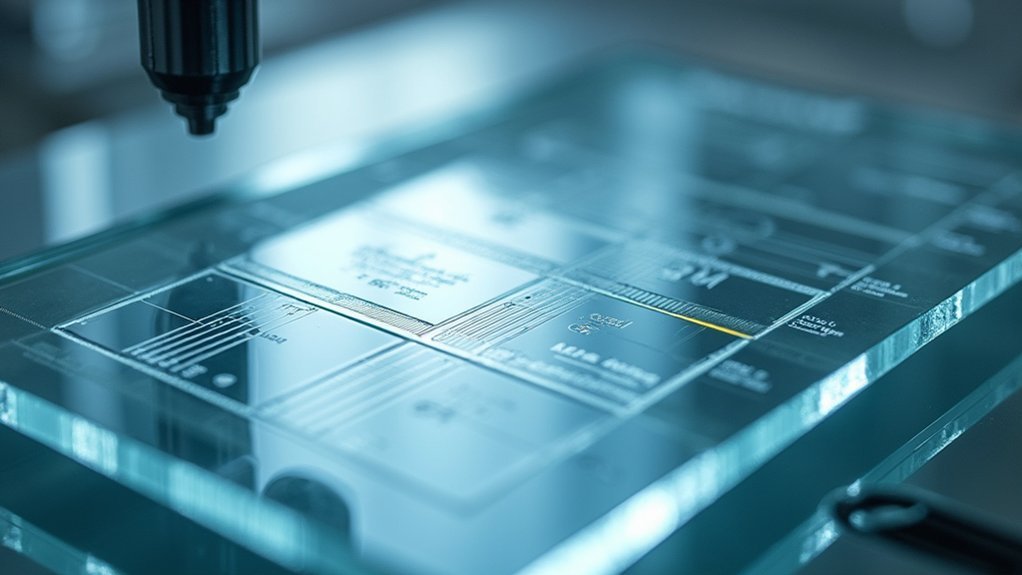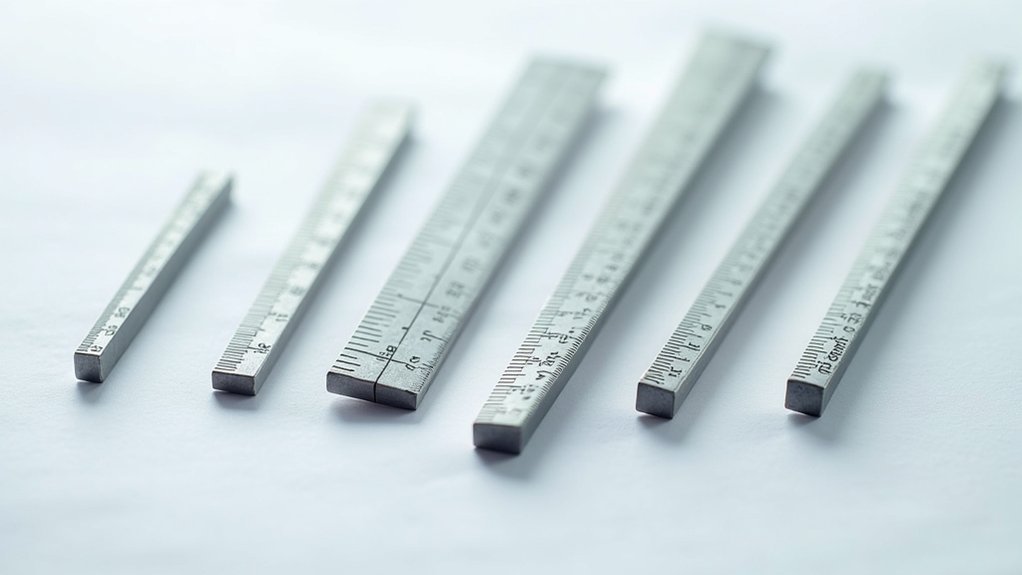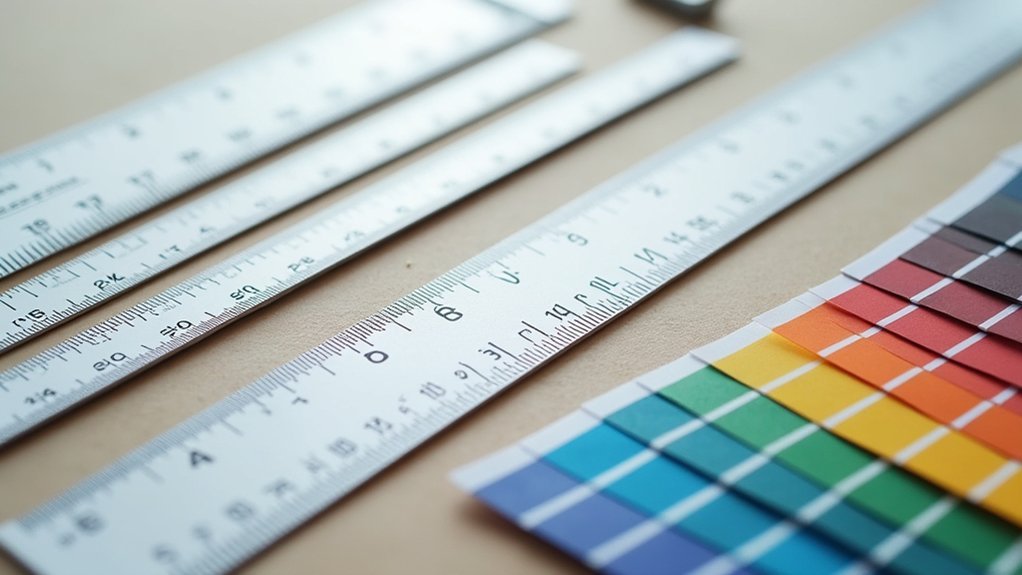Phase contrast specimens are mounted between glass plates to create uniform thickness and consistent optical path lengths, essential for ideal contrast. You’ll achieve clearer images as the glass minimizes phase distortions and helps maintain proper refractive index relationships. This technique protects your specimens from air bubbles and movement while enabling precise positioning in the microscope’s optical path. Master this fundamental approach and you’ll access considerably enhanced detail in transparent biological samples.
Optical Principles Behind Glass Plate Mounting

When you mount specimens between glass plates for phase contrast microscopy, you’re leveraging fundamental optical principles that dramatically enhance image quality.
The glass creates a uniform thickness throughout your sample, ensuring consistent optical path lengths that minimize phase distortions during imaging.
Uniform thickness created by glass plates maintains consistent optical paths, preventing distortion during phase contrast imaging.
This mounting technique is effective because the refractive index of glass closely matches many biological specimens. This similarity maintains proper phase relationships as light passes through your sample, creating the contrast needed for detailed observation.
The glass plates also form a protective barrier that prevents air bubbles or debris from interfering with the light path.
Essential Components for Proper Specimen Preparation
Building on these optical principles, you’ll need specific materials to prepare phase contrast specimens effectively.
When working with transparent specimens, proper alignment between glass plates guarantees ideal interaction with your microscope’s annular diaphragm, resulting in high-contrast images that reveal cellular details invisible under brightfield conditions.
- Clean, dust-free glass slides and coverslips of appropriate thickness for your phase contrast objectives
- Phase-friendly mounting medium with refractive index matched to your specimens
- Precision spacers to maintain consistent specimen thickness between glass plates
- Anti-vibration staging to prevent disruption of the delicate phase relationships
- Specialized sealants that won’t introduce artifacts while securing the glass plate assembly
These components work together to maintain specimen integrity while maximizing the phase shifts that create the contrast you’re seeking.
Step-by-Step Glass Plate Mounting Technique

To guarantee ideal phase contrast imaging, you’ll need to master the precision of glass plate mounting techniques.
Begin by selecting clean glass plates with the standard 0.17 mm thickness that’s compatible with your phase contrast objectives.
Place your specimen in a small droplet of appropriate medium on the first plate. Carefully lower the second plate at an angle to avoid trapping air bubbles that could disrupt the consistent optical path.
Apply gentle, even pressure to create uniform thickness across the entire preparation.
For live cells, work quickly to ascertain viability while achieving proper stabilization.
Secure the edges with a small amount of petroleum jelly if needed for extended observation periods.
This mounting method protects delicate specimens during handling while maximizing image clarity by minimizing additional refractive indices.
Benefits of Glass Plates for Image Clarity and Resolution
The superior optical properties of glass plates directly translate to enhanced image quality in phase contrast microscopy. When you mount specimens between these plates, you’ll achieve sharper images with improved resolution and detail definition.
- Glass plates minimize specimen movement, providing stability essential for capturing fine cellular structures.
- Uniform refractive index across glass surfaces reduces optical aberrations that would otherwise blur images.
- Consistent specimen thickness maintained by flat glass surfaces optimizes phase shifts for superior contrast.
- Improved light path alignment through glass reduces scattering, enhancing resolution of minute details.
- Precise positioning within the optical path becomes easier, allowing you to focus on specific regions of interest.
Troubleshooting Common Mounting Challenges

Despite careful preparation, you’ll likely encounter several common challenges when mounting phase contrast specimens. When placing samples between glass plates, avoiding excessive pressure is vital as it can alter the specimen’s refractive index and compromise image quality. Confirm your mounting technique preserves cell morphology, especially when working with live cells.
| Challenge | Solution | Impact |
|---|---|---|
| Air bubbles | Apply mounting medium slowly from one side | Prevents phase artifacts |
| Uneven thickness | Use spacers between glass plates | Maintains ideal phase contrast |
| Sample movement | Secure edges with sealant | Enables stable imaging of dynamic processes |
When troubleshooting mounting issues, remember that even minor adjustments to your technique can greatly improve results. The goal is achieving consistent optical path length throughout your specimen for clear, artifact-free phase contrast imaging.
Advanced Glass Mounting Methods for Specialized Specimens
For ideal optical clarity in specialized phase contrast specimens, you’ll need to select glass plates with consistent thickness and high transmission properties.
Position your specimen between these plates with minimal medium to reduce refractive aberrations that can distort phase relationships.
You can further enhance image quality by applying anti-reflection coatings to your mounting plates, effectively eliminating unwanted light scatter at glass-air interfaces.
Optimizing Optical Clarity
When pursuing exceptional phase contrast imaging, proper glass mounting techniques become essential for maximizing optical clarity. Your specimen’s stability between high-quality glass plates considerably enhances the final image by creating consistent optical conditions.
- Mounting between glass plates minimizes movement and vibration, ensuring stable specimens for clearer observations.
- High-quality, optically clear glass reduces light scattering and refraction, improving light transmission.
- Standardized specimen layer thickness maintains consistent optical path lengths, minimizing phase artifacts.
- Proper mounting facilitates easy manipulation and positioning without compromising image quality.
- Glass plates protect delicate specimens from dust and contamination that could interfere with clarity.
Minimizing Refractive Aberrations
Refractive aberrations pose significant challenges in phase contrast microscopy, particularly with specialized specimens that demand pristine optical conditions.
When you mount specimens between glass plates, you create a uniform optical path that dramatically reduces these aberrations by minimizing variations in refractive index that would otherwise distort your images.
Select the appropriate glass thickness—typically 0.17 mm for standard microscopy—to maintain ideal working distance for your phase contrast objectives. This guarantees effective functioning of annular rings and phase plates while keeping specimens close to the objective lens.
The glass mounting technique also prevents specimen movement and dehydration, preserving delicate structures essential for accurate observation.
For transparent or fragile specimens, this approach is invaluable as it maintains morphological integrity while enabling high-resolution imaging free from the distortions that compromise analytical precision.
Frequently Asked Questions
What Is the Purpose of a Phase Plate an Optically Thin Phase Shifter in Phase Contrast Microscopy?
The phase plate shifts light waves to create quarter-wavelength differences between direct and scattered light, letting you see transparent specimens clearly without staining. It’s mounted in the objective lens to enhance cellular details.
What Is the Purpose of Phase Contrast Microscope?
You’ll use a phase contrast microscope to visualize transparent specimens without staining. It converts light phase shifts into visible amplitude differences, letting you observe living cells and their structures in real time.
What Are Some Advantages of Phase Contrast and Differential Interference Contrast Microscopy?
You’ll see live, unstained cells with phase contrast microscopy, while DIC gives you 3D-like images with better resolution. Both techniques let you observe living specimens in real-time without harming them.
What Is the Function of the Phase Ring in Phase Contrast Microscopy?
In phase contrast microscopy, the phase ring transforms phase differences into visible contrast. You’ll find it converts light phase shifts into brightness variations, letting you see transparent specimens without staining them.
In Summary
You’ll find glass plate mounting indispensable for phase contrast microscopy. By creating the ideal refractive environment, glass plates eliminate unwanted artifacts and guarantee consistent specimen thickness. They’ll protect your delicate samples while providing superior optical clarity that simply isn’t possible with other methods. Master this technique and you’ll achieve sharper images with enhanced contrast, revealing fine structural details that might otherwise remain invisible.





Leave a Reply